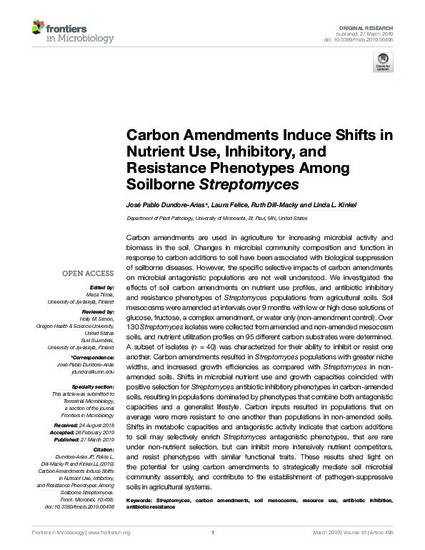
Article
Carbon Amendments Induce Shifts in Nutrient Use, Inhibitory, and Resistance Phenotypes Among Soilborne Streptomyces
Frontiers in Microbiology
(2019)
Abstract
Carbon amendments are used in agriculture for increasing microbial activity and biomass in the soil. Changes in microbial community composition and function in response to carbon additions to soil have been associated with biological suppression of soilborne diseases. However, the specific selective impacts of carbon amendments on microbial antagonistic populations are not well understood. We investigated the effects of soil carbon amendments on nutrient use profiles, and antibiotic inhibitory and resistance phenotypes of Streptomyces populations from agricultural soils. Soil mesocosms were amended at intervals over 9 months with low or high dose solutions of glucose, fructose, a complex amendment, or water only (non-amendment control). Over 130 Streptomyces isolates were collected from amended and non-amended mesocosm soils, and nutrient utilization profiles on 95 different carbon substrates were determined. A subset of isolates (n = 40) was characterized for their ability to inhibit or resist one another. Carbon amendments resulted in Streptomyces populations with greater niche widths, and increased growth efficiencies as compared with Streptomyces in non-amended soils. Shifts in microbial nutrient use and growth capacities coincided with positive selection for Streptomyces antibiotic inhibitory phenotypes in carbon-amended soils, resulting in populations dominated by phenotypes that combine both antagonistic capacities and a generalist lifestyle. Carbon inputs resulted in populations that on average were more resistant to one another than populations in non-amended soils. Shifts in metabolic capacities and antagonistic activity indicate that carbon additions to soil may selectively enrich Streptomyces antagonistic phenotypes, that are rare under non-nutrient selection, but can inhibit more intensively nutrient competitors, and resist phenotypes with similar functional traits. These results shed light on the potential for using carbon amendments to strategically mediate soil microbial community assembly, and contribute to the establishment of pathogen-suppressive soils in agricultural systems.
Keywords
- Streptomyces,
- carbon amendments,
- soil mesocosms,
- resource use,
- antibiotic inhibition,
- antibiotic resistance
Disciplines
Publication Date
March, 2019
DOI
10.3389/fmicb.2019.00498
Citation Information
Jose Pablo Dundore‐Arias, Laura Felice, Ruth Dill-Macky and Linda L. Kinkel. "Carbon Amendments Induce Shifts in Nutrient Use, Inhibitory, and Resistance Phenotypes Among Soilborne Streptomyces" Frontiers in Microbiology Vol. 10 (2019) Available at: http://works.bepress.com/jp-dundore-arias/3/
Creative Commons license

This work is licensed under a Creative Commons CC_BY International License.
